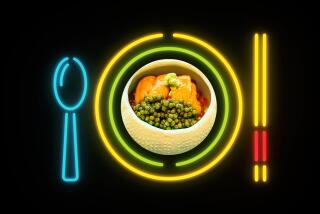Feeding the Family With Fish and Chips
- Share via
LEEDS, England — Anything you ever wanted to know about fish and chips you can learn from Arnold Scholes, who has skinned, battered and fried Britain’s most famous fast food for 50 years.
The man knows his cod and can talk for hours about potatoes. But please, don’t get Scholes started on quality of cooking oil, for if there’s anything he loathes more than a McDonald’s meal, it’s a bag of limp and soggy fish and chips served up by a disinterested fryer.
“The fryer is letting himself and his trade down by turning out an inferior product,” he says. “You have to have standards.”
Scholes is helping maintain those standards as an instructor at the school of fish and chips, a three-day program offered monthly by Britain’s National Federation of Fish Friers. More than 100 students a year flock to an industrial kitchen in this fish and chips hotbed to learn the secrets of a good fish fry. The class has lured students from as far away as Sweden, Romania, Australia and the United States.
Preparing fish and chips may not be as difficult as mastering the art of French cuisine, but it takes a strong stomach and a steady hand to skin a haddock.
And there really is a trick to making good fish batter. It’s called very cold water.
Students also learn how to use an electric potato peeling machine--very carefully--and are instructed on the proper way to place the fish in the oil (as one would place a baby in a crib).
“We try to break down that aversion to touching fish,” Scholes says.
Even in this era of fast-food burger chains, pizza parlors and fried chicken joints, the plain and simple virtues of a bag of fish and chips continue to lure the British public. A recent poll showed that half the population eats fish and chips at least once a month.
The $1-billion-a-year industry also serves as a safe harbor for individual entrepreneurs with cash, courage and commitment. Chains are the exception rather than the rule, as 8,500 take-out shops, operated mainly by married couples, annually sell 60,000 tons of fish and 500,000 tons of potatoes.
Many towns in the north of England claim to be the birthplace of fish and chips. Fried fish was initially sold from baskets in English cities in the early 19th century, with fried potatoes introduced from France around 1865. The two products were then joined, wrapped inside newspapers and topped with plenty of salt and vinegar.
The early fish and chips shops were generally found in the living rooms of working-class homes, as more than 25,000 outlets once dotted a landscape that reeked of cooking oil. No wonder it was known as an obnoxious trade. During the height of World War II, when most food in Britain was rationed, fish and chip shops served food that was cheap and plentiful.
The product is still cheap--about $3 a serving in most take-outs--but it takes more than a low price to lure the public. And that’s why 12 students a month make the trek to the fish and chips school.
Here, the students are regaled with fish and chips tales and know-how by Scholes and Arthur Parrington, the general secretary of the national federation. These men are the galloping gourmets of the fish and chips business as they enthusiastically take the students through the cooking process.
“The thicker the chip, the less fat they hold, and the more flavor you’ll get,” Parrington tells the students, who dutifully write the information in their notebooks.
“We believe the best batter is made by hand with a whisk,” he adds. The students nod.
Scholes is particularly emphatic about the electric potato peeler. Run it for one minute, there’s hardly any weight loss for the potatoes. But run it for two, and two pounds of potatoes go right down the drain.
Scholes and Parrington also offer instruction on buying, outfitting and maintaining a shop. They also point out the potential pitfalls of a trade that demands long hours, eating into time spent with the family.
“This is hard work, but it can be rewarding,” Parrington says. “If two people are coming into the business together, they need to be compatible. There is no point in coming into the business if the man is keen on it and the wife wants nothing to do with it.”
And yet, despite the potential hardships of entering the fast-food trade, there appears to be no shortage of men and women willing to call themselves fish fryers.
Seema and Wayne Price were among the dozen students who learned their frying skills in October. Seema shed her job as a telephone operator, and Wayne gave up his career as a deep sea diver. On the first day, Seema had trouble skinning the haddock, while Wayne wasn’t exactly quick with the frying tongs.
“Diving is no trade for a married man,” Wayne says. “Running a shop, we can run our own business and our lives. We needed the crash course.”
By the third day, the Prices had earned their graduate certificates and were ready to enter the fish and chips trade. They even had a name picked out for the shop they’ll soon open: Moby Dick’s.
More to Read
Sign up for The Wild
We’ll help you find the best places to hike, bike and run, as well as the perfect silent spots for meditation and yoga.
You may occasionally receive promotional content from the Los Angeles Times.






